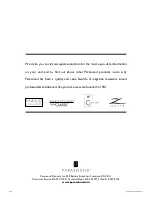
TECHNICALLY SPEAKING
Bass and Treble Controls
The bass and treble controls offer adjustment of overall tonal balance in the front left, center, and
right channels. The Bass controls allow you to boost or cut low frequencies ±12 dB at 20 Hz, in
1-dB increments. The Treble controls allow you to boost or cut high frequencies ±12 dB at 20 kHz
in 1-dB increments. To preserve sonic clarity, use these controls sparingly and only for recordings
that actually sound better with tonal correction. You will find that very slight adjustments can add a
degree of warmth, richness, clarity and airiness. However, greater adjustments may obscure musi-
cal detail, and even risk overloading your speakers. Bass and treble controls do not affect the Rec/
Out or Zone outputs, but their effect can be heard when playing back through the Play/In input.
IR Repeater Input Jacks
The
IR Inputs
on the rear panel of the 7100 are used for connecting the 7100 to the termination
“amplified block” of wired infrared repeater sensors or system controllers. The
IR Input jacks
accept standard 1⁄8” (3.5 mm) two conductor mini-plugs, with the positive wired to the plug’s tip
and the negative to its sleeve. Your Authorized Parasound Dealer or custom installer can
recommend a compatible infrared repeater system for the 7100.
Preventing or Minimizing Hum and Buzz
Audible hum and buzzing noises in a system are usually related to issues with the component
grounds. Ground (sometimes called common) is a point of reference for voltages in virtually all
audio and video components. Every component has its own ground reference, and the audio
signal swings positive and negative in relation to that. Problems occur when components with
slightly different grounds are connected together. Such “ground loops” allow unwanted voltages
to flow between the components. This causes an audible hum at the frequency of the local AC
power line or “mains power” (60 Hz in some regions, 50 Hz in other regions). Harmonics which
may be present with 60 Hz AC power are 120, 240, and 480 Hz, etc. Harmonics which may be
present with 50 Hz AC power are 100, 200, and 400 Hz, etc. These harmonics can add buzz in
addition to the hum.
Here are two tips to avoid hum and buzz:
1. Keep the components in your system close together, with their power cords plugged
into a common AC outlet or power strip, to avoid problems created by resistance in the
house’s wiring.
2. When rack mounting, always use insulated “shoulder” washers. These break the ground
loops caused by metal-to-metal contact between the rack, the 7100’s front panel, and other
rack-mounted components. Insulated shoulder washers are included with the Parasound
RMK33 rack mount kit for the Model 7100.
Headphone Circuit
The 7100 includes a high-quality headphone amplifier. It is suitable for headphones with an
impedance of 8 ohms or higher. The
Headphone jack
accepts a standard 1⁄8” (3.5 mm) stereo
mini-jack. If your headphones have a 1⁄4” jack, you will need a stereo 1⁄4” jack-to-stereo 1⁄8”
mini-plug adapter.
Video Signal Formats
The 7100 can handle the three common video signal formats: Composite Video outputs, S-Video,
and Component Video.
Composite Video
combines all the elements of the video signal and passes them through a
two-conductor cable. It therefore offers the least vivid and detailed video images. It is, however,
the most widely used home video connection standard, largely because it is the oldest. In the
7100, composite video input signals are fed not only to the
Composite Video Output jacks
, but
also to the
S-Video
and
Component Video Output jacks
. RCA connectors, usually yellow, are
used almost universally for this format.
59














































